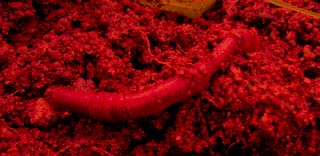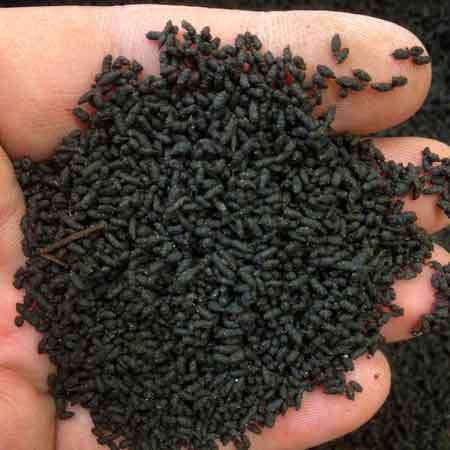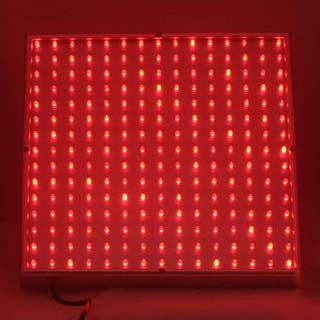Light
Red Light Doubles Vermicompost Production
Red light has been shown to provide benefits for many living organisms on earth. This includes all plant life, a wide variety of bacteria/micro-organisms, fish, small animals, dogs, horses, humans, but also insects, snails and worms. As a natural component of sunlight this should come as no surprise.
Light for worms?

It does seem somewhat counterintuitive regarding earthworms, however, that red light might benefit them, as earthworms are generally averse to light. Worms don’t have eyes as such, but they have cells similar to those cells in our retina that are light sensitive.
Worms are actually harmed by direct sunlight or avoid it for several reasons including:
- Being exposed to open sunlight causes their skin to dry out, suffocating them (worms breathe via the skin) and increasing friction, damaging their skin upon movement.
- From an evolutionary perspective, being in open light increases chances that they will be seen by predators such as chickens and birds. They’ve evolved to avoid that risk.
- UV light can pass through the entire body of a worm, so while us humans only get sunburn, worms get dangerous full body burn.
Basically, natural sunlight exposure is lethal to worms, in a variety of ways. So why exactly is red light beneficial for worms? How can we be sure? What downstream effect could this have on soil and plants in the soil?
How red light improves worm function and casting quantity
Sunlight is a broad spectrum of light, containing wavelengths from ultraviolet, through all the colours of the rainbow, and also infrared light. Red light is a much narrower spectrum, occupying only a small range of wavelengths. More info here.
The effects in worms are best shown by the below table (taken from the study: “Effects of light colour and oscillator frequency on earthworm bioactivity” Owa, et al., 2007):

Worms under the red light processed by far the most organic material and produced the most worm casting. Compared to the worms receiving no light at all (which is standard in most vermicomposting), red light supplemented worms produced 66% more castings. A huge difference.
Standard white light seems to have an overall negative impact, reducing production by over 30%. Green and blue light have a positive effect on cast production, albeit less than red’s. Although, judging from worm emigration rates, they were uncomfortable under both green and blue, showing the least tolerance (they wanted to escape). They showed the most tolerance to dark and also red. This suggests that the worms were both comfortable and productive under red light, but stressed (and productive) under blue. It also suggests that worms are comfortable in the dark, but not optimally stimulated by darkness.
This study shows that the benefits are definitely from the colour of the light, not the heat produced (as all colours of light produced the same low heat). Worms seem to benefit the most from red light, and are harmed the most by UV (or spectrums containing UV like white/sunlight).
Other studies show similar results, with earthworms either being more efficient because of red light, or all congregating towards areas with red light (Wu HP et al., 2011. de Souza et al., 2005. Lopes KA et al., 2009). Worms just love red light.
Almost every type of light has a biological effect on organisms. UV can cause sunburn, but also vitamin d production, blue light can trigger photosynthesis, but also retina damage, etc. Red light primarily stimulates energy (ATP) production in mitochondria (Tafur et al., 2008. Begum et al., 2013. Morimoto Y et al., 1994. etc.) via a respiratory enzyme called cytochrome c oxidase.
The reason that red light is beneficial for all organisms is because we all have mitochondria (plants, animals, bacteria, fungi) and they all function in more or less the same way. Respiration is one of the most primitive/primary foundations of life…and red light interacts to enhance it.
By looking at this equation above, we can see several things. Not only will red light make worms produce more energy (so they can process more material into worm castings), but also increases the total carbon dioxide produced by the worms. This is most significant if plants are being grown nearby, as carbon dioxide dramatically improves plant growth. So not only do the worm castings themselves improve plant growth (via soil quality), the worm’s respiration also improves plant growth by producing co2. Both worm castings and co2 production are enhanced by red light.
How worms produce quality soil

As the organic matter decays, worms can eat the microorganisms growing on it and those in the soil. They can also eat very small pieces of food directly. Various factors affect the rate at which worms will process the compost, such as; temperature, type of feed, moisture, oxygen availablity, species of worm, pH, pests and lighting.
The worm castings produced by this process are a mineral rich fertiliser and soil conditioner, that enhance plant growth (germination, roots, crop yield), improve overall soil quality (aeration, microorganisms, water capacity) and even have broader environmental benefits (van Groenigen et al. 2014).
Use pure red light only – for worm health
Using just any source of red light to improve worm function isn’t recommended as most high powered lights put out excess heat. Red heat lamps, incandescents, HPS, red halogen and pretty much every other type of red light fall into this category. The main exception is red LEDs.

Tentative vermicompost lighting recommendations
Below are initial recommendations, a starting point if you will, based on the limited available studies at this point in time.
For large-scale vermicomposting a series of high powered, red spectrum only, 100w+ LED lights (the same as red-only plant grow lights typically used for ‘flowering’) would be optimal. The light(s) should be placed directly above the active part of the worm bin, high enough that the light spread covers from side to side.
For small-scale vermicomposting a lower powered 5 to 15 watt red LED light would be optimal, positioned centrally on the ceiling of the worm bin. Even something like red Christmas lights could work, or a red LED panel. This could be used all day long, especially in outdoor bins in winter.
Summary
Red light is beginning to be acknowledged as an essential component of vermicomposting, bringing the worms to maximum effectiveness. The potential is exciting with perhaps a doubling of worm cast production in an optimal configuration. There are many potential lighting options for large and small scale worm bins, depending on the size and depth. We need more studies and experimentation from the vermiculture community to see what works best.
If you have tried red light in your own vermicompost equipment or have any information/anecdotes to share, please leave a comment below!
References
African Journal of Agricultural Research Vol. 3 (1), pp. 029-036, January 2008. Effects of light colour and oscillator frequency on earthworms – Owa, et al.
J Photochem Photobiol B. 2011 Feb 7;102(2):156-60. Increased mobility and stem-cell proliferation rate in Dugesia tigrina induced by 880nm light emitting diode. Wu HP, Persinger MA.
J Photochem Photobiol B. 2005 Sep 1;80(3):203-7. Low power laser radiation at 685 nm stimulates stem-cell proliferation rate in Dugesia tigrina during regeneration. de Souza SC, Munin E, Alves LP, Salgado MA, Pacheco MT.
Braz J Biol. 2009 May;69(2):327-32. A study of low power laser on the regenerative process of Girardia tigrina (Girard,1850) (Turbellaria; Tricladida; Dugesiidae). Lopes KA, Campos Velho NM, Munin E.
Scientific Reports 4, Article number: 6365 (2014). Earthworms increase plant production: a meta-analysis. Jan Willem van Groenigen, Ingrid M. Lubbers, Hannah M. J. Vos, George G. Brown, Gerlinde B. De Deyn & Kees Jan van Groenigen
Rana Begum, Michael B. Powner, Natalie Hudson, et al. Treatment with 670 nm Light Up Regulates Cytochrome C Oxidase Expression and Reduces Inflammation in an Age-Related Macular Degeneration Model. February 28, 2013.
Lasers Surg Med. 1994;15(2):191-9. Effect of low-intensity argon laser irradiation on mitochondrial respiration. Morimoto Y, Arai T, Kikuchi M, Nakajima S, Nakamura H.
Photomed Laser Surg. 2008 Aug; 26(4): 323–328.
Low-Intensity Light Therapy: Exploring the Role of Redox Mechanisms. Joseph Tafur, and Paul J. Mills.



In theory wouldn’t it be a dark pink, think green inverse, carbon uptake/ carbon output, though red are more common lighting bulbs(cept in greenhouses). I’d think it a flowering range.
Not sure I quite understand what you’re getting at.
Try to think less in terms of colour, and more in terms of wavelengths of the light. The worms (and plants also) respond to light in the 600-700nm range for respiration, which is the most likely mechanism here.
Something worth considering as an integration for a self powered system science.howstuffworks.com/environmental/green-tech/sustainable/soil-lamp.htm
Thanks for the link – some great ideas there that I’d never heard of. These soil lamps, solar or wind power seem to provide great ways to keep a worm bin LED setup self-powered.
Very interesting. .. maybe the red light works because of proto-Saturn?
BUT!
Can worms sense this coloured light with their retina like skin cells and whatnot?
do they have an eye cone thing, ’cause I’m really, really, confused here. I know when they sense light they move. But red light doesn’t seem to bother them, so maybe they can’t sense it at all. I don’t know where I’m going here. And why do the Worms only respond to the light range of 600nm – 700nm for respiratory?
The worms will move to an area with red light, so they must sense it on some level. They have some ability to sense light yes, through retina-like skin cells, although I am not sure if the red light sensing is more just a relaxing feeling they get (which attracts them).
A lot of animals cannot see red light, including dogs and cats, so perhaps you are right.
Worms move when they sense ultraviolet or blue/white light, not necessarily light in general.
600-700nm of light will be absorbed by the mitochondria in worms, due to the cytochrome oxidase enzyme.
Have any studies been done to know if the lights need to be kept on all the time?
Fascinating – Would a red filter as a lid on a worm bin have the desired effect ?